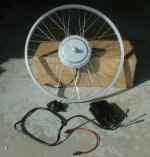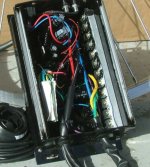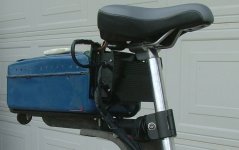The last thing, or the first if you take it to a shop for it , is to true the wheel. Aotema sends them out pretty rough. Or they get that way in transit. Either way, you really need to get the wheel trued at a shop before you install it, or do it yourself if you know how. It can be tricky, and on a motor wheel spokes can break and the thing will be more likely to get out of round since it gets pounded with the extra weight. This one was pretty bad, lots of wobble, and some egg shape too. Dang! I'm good at wobble, but getting the egg shape round again is harder for me. A half hour of tuning and I got it pretty good. After a few miles of test riding, it only took a few minuites more to get it real nice. I thought it would be harder, but it wasn't. Other vendors ship a better trued wheel on a higher quality rim, but not usually at these prices. This kit is a good value, but not the top of the line. I find it pretty easy to do my own truing, but sometimes I will take a wheel to the shop just to avoid doing the work. Even if you spend 20 bucks to get the rim dialed in, it is still not very expensive. If your shop is charging more than that, find another. Even a well tuned wheel could be bent a bit by the gorillas at UPS. With all that weight, if it gets dropped off a conveyer it can bounce pretty hard.
So now I'm ready to ride. Everything hooked up, tested and it works fine. First I check the hub nuts one more time, and sure enough, one nut can be turned another 1/8 turn. Overnight the washer has settled in on one side and loosened up a hair. I keep those nuts tight, but not overtight. Too big a wrench and you can strip em, but they do need to be tight. I use a 6 inch handle crescent. Someday I'll have to get the right wrench, I have 17mm and a 19 mm, but this seems to take an 18 mm.
Despite the lack of hall sensors, this motor seems able to start itself without pedaling. This is my first brushless motor, so it is a lot different. If you pick the wheel off the ground, and hit the throttle, it may back up a tiny bit, then start forward and start running. With your weight on the bike, it can be a bit slow to get going, but if you don't want to pedal, you can just throttle and go. It seems to like it a lot better though, if you don't give it full throttle too quick, and better still if you just push off a little or pedal lightly to get going. Compared to the brushed motor, which was also an Aotema, it makes a bit more noise, especially when just starting out. The slight growly noise, which is normal and expected, turns to a low whine as speed picks up and pretty much dissapears when at full speed. I kinda like it, when the whine gets loud, I know I should be pedaling a bit harder. On a hill, the tone of the whine tells me exactly how much strain the motor is going through. Keeping the pedaling up and the whine down should extend my range. It seems to work good, no halls to worry about, especially if you live in the wet places, yet you don't absolutely have to pedal first to get going. Cool. I tried to do some hard starts to see if my battery bms would trip, but it didn't.
Speed was suprising. I knew the WE brushless sold last year would only do about 20 mph with a 36v battery. Acutally I run about 44 volts for the majority of any ride, since I use a lifpo4 36v pack. So I was expecting around 19-20 mph. Instead I find it has speed on the flats that is just about one mph less than the brushed motor I have used all last year. So my 36v flat speed was just about 22-23 mph. For me that is fast enough. Faster than that gets scary, bends wheels, and gets the cops looking at ya. Downhill, on very shallow grades, 25 mph is easy. So there you have it, this motor is definitely faster than the Wilderness Energy kits sold last summer, or still selling now from the same stockpile. I am going to guess for now that it would do about 27-28 mph on the flats at 48v. Bear in mind my bike has tall handlbars, knobby tires, and I ride it sittng straight up, catching all kinds of wind drag. So this motor passes the test for speed for me. I'm not looking to get tickets, but I do want to do better than 17 mph when I have 15 miles to go, morning and night. It is so close to the motor I'm used to, that I won't be having to leave the house early to make it to work on time.
But sometimes a fast motor can have less torque, because of the winding count. My commuting route is from the high plain above the valley, down 800 vertical feet, and then along the valley edge up and down some short but steep hills for a total of 15 miles. Not so bad. Now try to get home in the evening. Good luck buddy. After about 6 miles of steep ups and downs, the big hill comes. About a half mile of 5% then a full mile of 10%. Then a long slow climb up the high plain on an easy slope, but not so easy if the battery is down to nothing. So hill climbing ability is real real, real important to me. Much to my suprise, when I went down to the big hill and came back up, I set a new record for speed. WOW! I had read stuff about how brushed motors climbed hills better, but I can tell you right now this motor can climb a pretty steep hill. Just for grins, I went back down and tried to climb it , no pedaling. It nearly did it, no way could the brushed motor do that. I finally pedaled just a bit at the top to keep speed above 10 mph. I also tried backing off the throttle and climbing slower but pedaling to help. That worked fine too. With the old brushed motor, half throttle would just come to a stop, and you would have to floor it, or walk. VERY NICE! I have no other brushless motor to compare with, but this new one from hightekbikes.com is clearly adequate for some pretty steep hills.
Ok but what about the 1000 pound gorilla in the room, HEAT? Heat is my biggest ev problem. I live in the desert, and when I ride 15 uphill miles home, it can be 110 F by noon. Roads melt, shoes melt, and of course last summer I melted a brushed motor. So while I rode up and down hills for 15 miles today, I kept feeling the motor to see if it got very hot. My old brushed motor would get pretty hot going downhill, even on some chilly mornings. Coming back up, it was not unusual for it to be over 150F. Today was coolish, only about 50 F but still, for about 10 miles I coudn't even feel any warmth coming out of the motor. After 15 hard miles at full throttle, it finally got warmish. I forgot to bring my thermometer, but I doubt it exceeded 100F. Heck a ride around the block on the brushed motor would make that much heat. Wow, I expected a cooler motor only if it was slower, but not only is this motor fast, good on hills, and it runs cool too! It seems like a pretty great hubmotor to me!
Range is yet to be determined, but lately the brushed motor could barely take me 14 miles, and this one just did 15 with no signs of a low battery. I'll be keeping track of the watts used in a roundabout way, by logging the kilowatt hours the charger uses with a killawatt meter. A full drained battery is taking about .73 kwh to charge.
All in all I'm very pleased with this motor at first impression. A good truing before shipping would be an improvement, but as long as the customer is expecting to need to get it straightened that is an easy to solve issue. The motor is fast enough, 23 mph on the flat at 36v, but not so fast you are gonna get ticketed every day. It climbs well and doesn't overheat. I expect I am going to find this motor quite up to the task of taking me 30 miles a day, day in and day out, without straining my battery, my legs or my wallet. I would say buying this kit is a good idea for anyone wanting a solid motor at a reasonable price. A bargain kit is no bargain if it is too slow and won't climb a hill.
Once the winter ends and I start riding more again, I'll be logging a hundred miles a week or more, so keep an eye on this thread for updates every 500 miles or so. The real thumbs up on a motor kit is when you cross the thousand mile mark. The way I ride, full throttle all the way for 15 uphill miles is a real test for a motor. If I can't break it, I bet you can't. If I do break it, we'll know where the edges of the envelope are.












